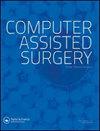相位对比磁共振成像中时间-速度曲线的分析:体模研究
IF 1.9
4区 医学
Q3 SURGERY
引用次数: 3
摘要
摘要本研究的目的是分析相对比磁共振成像(PC-MRI)获得的时间-速度曲线特征,以体外血流模型为血液动力学研究的参考。将PC-MRI的时间-速度曲线与多普勒超声(US)以及电磁流量计的时间-速度曲线进行了比较。以电磁流量计为参考标准,分析了各技术间的相关性;时间-速度曲线测量了最大、最小和平均速度,半最大全宽度(FWHM)和上升梯度(AG)。发现电磁流量计与PC-MRI和多普勒US各自测量技术之间的相关性很高(平均R2 > 0.9, p < 0.05)。这些结果表明,这些测量技术是有用的测量血流信息和反映实际流量。PC-MRI最适合最小速度和FWHM,最大速度和AG最适合多普勒US。PC-MRI显示最大速度值低于多普勒超声,最小速度值高于多普勒超声。因此,PC-MRI表现出比多普勒US更钝的时间-速度曲线。此外,PC-MRI的时速度曲线可以通过引入公式进行校准,该公式可以在10%的误差范围内将每个测量值转换为参考标准值。PC-MRI可用此公式估计多普勒超声。本文章由计算机程序翻译,如有差异,请以英文原文为准。
Analysis of the time-velocity curve in phase-contrast magnetic resonance imaging: a phantom study
Abstract The aim of this study was to analyze the characteristics of time-velocity curve acquired by phase-contrast magnetic resonance imaging (PC-MRI) using an in-vitro flow model as a reference for hemodynamic studies. The time- velocity curves of the PC-MRI were compared with Doppler ultrasonography (US) and also compared with those obtained in the electromagnetic flowmeter. The correlation between techniques was analyzed using an electromagnetic flowmeter as a reference standard; the maximum, minimum, and average velocities, full-width at half-maximum (FWHM), and ascending gradient (AG) were measured from time-velocity curves. The correlations between an electromagnetic flowmeter and the respective measurement technique for the PC-MRI and Doppler US were found to be high (mean R2 > 0.9, p < 0.05). These results indicate that these measurement techniques are useful for measuring blood flow information and reflect actual flow. The PC-MRI was the best fit for the minimum velocity and FWHM, and the maximum velocity and AG were the best fit for Doppler US. The PC-MRI showed lower maximum velocity value and higher minimum velocity value than Doppler US. Therefore, PC-MRI demonstrates more obtuse time-velocity curve than Doppler US. In addition, the time- velocity curve of PC-MRI could be calibrated by introducing formulae that can convert each measurement value to a reference standard value within a 10% error. The PC-MRI can be used to estimate the Doppler US using this formula.
求助全文
通过发布文献求助,成功后即可免费获取论文全文。
去求助
来源期刊

Computer Assisted Surgery
Medicine-Surgery
CiteScore
2.30
自引率
0.00%
发文量
13
审稿时长
10 weeks
期刊介绍:
omputer Assisted Surgery aims to improve patient care by advancing the utilization of computers during treatment; to evaluate the benefits and risks associated with the integration of advanced digital technologies into surgical practice; to disseminate clinical and basic research relevant to stereotactic surgery, minimal access surgery, endoscopy, and surgical robotics; to encourage interdisciplinary collaboration between engineers and physicians in developing new concepts and applications; to educate clinicians about the principles and techniques of computer assisted surgery and therapeutics; and to serve the international scientific community as a medium for the transfer of new information relating to theory, research, and practice in biomedical imaging and the surgical specialties.
The scope of Computer Assisted Surgery encompasses all fields within surgery, as well as biomedical imaging and instrumentation, and digital technology employed as an adjunct to imaging in diagnosis, therapeutics, and surgery. Topics featured include frameless as well as conventional stereotactic procedures, surgery guided by intraoperative ultrasound or magnetic resonance imaging, image guided focused irradiation, robotic surgery, and any therapeutic interventions performed with the use of digital imaging technology.
 求助内容:
求助内容: 应助结果提醒方式:
应助结果提醒方式:


